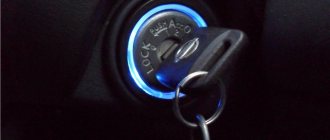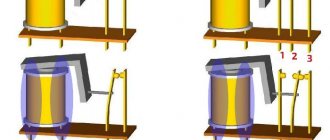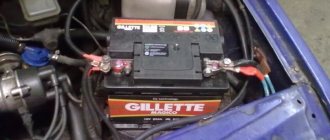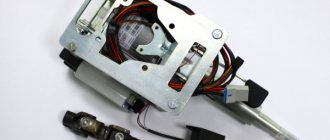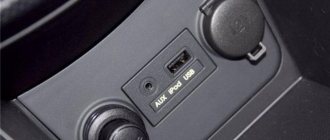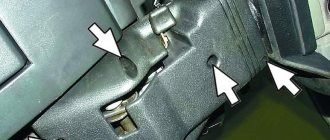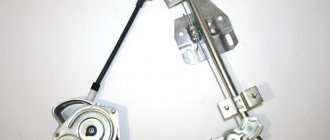There are two answer options to the frequently asked question about how to connect running lights. The first answer, the fastest, but not entirely economical, is to purchase branded running lights for the car, the connection diagram of which is fully reflected in the manufacturer’s instructions.
The second option is to make daytime running lights yourself, spending more time, but significantly saving your family budget, since manufacturing and connecting daytime running lights in this case will cost you at least twice as much, but you will also have to tinker. Since, despite all the apparent ease that is written about on various web resources, connecting running lights requires certain knowledge of electrical engineering and the skills of an auto mechanic.
In both cases, no matter which version of the daytime running lights connection diagram you decide on, first of all you will need information about regulatory requirements on the issue of what daytime running lights are, how to connect, and how to operate them correctly . That is, you need to know the requirements of GOST R 41.48-2004, which covers the installation and operation of daytime running lights.
In accordance with the requirements of this GOST, the connection diagram for running lights must ensure automatic switching on and off of running lights, namely: “If installed, daytime running lights must turn on automatically when the engine start/stop control is set to the “on” position.
It must be possible to activate and deactivate the automatic activation of daytime running lamps without the aid of a tool.
Daytime running lights must turn off automatically when the headlights are turned on, except when the headlights are turned on for a short period of time to signal road users."
The installation diagram for daytime running lights is from regular manufacturers, and the market today is dominated by Philips running lights and Hella running lights. quite simple due to its versatility.
The kits already include AMP series connectors, which are installed using the simple-click principle - with one click.
That is, when purchasing such LED daytime running lights, the installation scheme comes down to installing the blocks on the car body.
But, this ease of installation applies to modern car models. What about domestic cars or outdated modifications? In this case, the optimal optional installation diagram for navigation lights, which is described in great detail in GOST. The technology for making daytime running lights with your own hands has already been described in the corresponding topic.
Here you must understand for yourself that individually for each car, the scheme for switching on daytime running lights is different from each other. Therefore, in any case, it is necessary to consult a specialist - an auto electrician.
In the case when you carry out the second option of connecting running lights - with your own hands, you need to remember that in addition to the regulations for the optional installation of running lights, there is also a requirement for conversion. What are we talking about?
The circuit for switching on navigation lights, made independently, must avoid falling under the requirements of the same GOST R 41.48-2004, which says: “7.
1 Any change in the type of vehicle or the installation of its lighting and light signaling devices or any change in the description referred to in 2.2.
2, are brought to the attention of the Certification Body, which provided the certificate of conformity of type for this type of vehicle. This body can:
- 7.1.1 or conclude that the changes made will not have a significant adverse effect and the vehicle continues to comply with the requirements of this standard;
- 7.1.2 or require an additional protocol from a testing laboratory authorized to conduct tests.”
These are the difficulties you may encounter, despite the apparent ease of purchasing, manufacturing and installing car daytime running lights. But, if you think and count, the indisputable advantages of LED equipment, plus traffic regulations, all lead to the need to install daytime running lights.
https://www.youtube.com/watch?v=9753u6fapQY
Good luck on the roads, and in life too.
Source: https://carnovato.ru/skhema-podklyucheniya-dnevnykh-khodovykh-ogney-dlya-avtomobilya/
DIY running lights for VAZ 2107
Dear friends, we bring to your attention a diagram of the correct connection of DRLs on your car. Many people make DRLs on their own, many buy inexpensive Chinese DRLs and simply connect them parallel to the ignition; not everyone has the opportunity to buy branded Philips DRLs for 80 bucks, which themselves will be tailored for proper connection. And the whole nuance of connecting the DRLs is that not only must they be turned on when starting the engine, they must also turn off when the low beam is turned on, according to technical regulations! Since DRLs are very blinding at night, we do not mean barely smoldering daytime running lights of unknown origin, but we assume that you have fairly bright running lights. Here is a universal, competent connection diagram, suitable for any VAZ and any DRLs.
Do you have your daytime running lights connected correctly? ????
Daytime running lights have nothing to do with dimensions and are lighting devices that improve the driver's visibility during the daytime.
The standard DRLs are LEDs, which shine brightly and have a long service life. When you use daytime running lights on a VAZ 2107, you should not additionally turn on the low beam or fog lights.
Installation rules
Installation of additional lighting on a domestic car does not require qualifications or experience. However, if installed incorrectly, you risk running into a fine from traffic cops, becoming the owner of an administrative violation.
To prevent this from happening, connect the running lights yourself, following the rules:
- read GOST R 41.48-2004. It concerns the rules for installing lighting devices on a car and vehicle certification in this regard. All the parameters that you must consider when installing these devices are written there;
- select the appropriate DRL body shape. Keep in mind that not all lighting devices are suitable for the VAZ 2107. Drivers consider Philips Led Daylight 9 DRLs to be the best choice in terms of price-quality ratio;
- Check the housing size for correctness, taking into account the blocks of adjacent Daytime Running Lights. Install lighting fixtures in the air intake or on the bumper, depending on the situation;
- The height of the framed product body is 250–1500 mm from the road surface. The width between the inner edges of 2 surfaces visible on the car must be at least 600 mm;
- the products are located in front of the machine, and the beam of rays is directed forward;
- Consider the overall brightness of the LED lighting. It ranges from 150 to 330 lumens.
Hola oil filter reviews
Installation process
After purchasing regular or flexible DRLs with a turn signal function, you are faced with the question: how to connect new devices to the VAZ? This requires:
- take a five-pin relay from a domestic manufacturer;
- to contact No. 30, take a positive charge from the ignition (alternatively, a wire from the button responsible for heating the rear window);
- connect connection No. 86 to the low beam using the button for activating the headlights and low beams;
- No. 85 - throw on ground;
- No. 88 - connect to DRL;
- No. 87 is not required during operation and is not connected to anything.
Relay - put it in the cabin. Under the car hood, run only the wiring that goes directly to the lighting fixtures.
This connection diagram for the daytime running light on the VAZ 2107 automatically turns on the LEDs when the ignition key is inserted and turns them off when the engine is turned off.
In addition, when the vehicle's low beams are on and the engine is running, the lights will go out and turn on again when the daytime running lights are turned off.
After the adoption of the law making the use of daytime running lights (DRLs) mandatory when driving, most motorists began to fuss about having these attributes installed on their vehicles. The adoption of such a law is a decision to improve road safety on highways and large populated areas.
Front lights
The front part of the car usually attracts more attention, so amateurs begin to tune primarily the headlights.
Evil headlights
It’s very easy to give your car a menacing, gloomy and even evil look: just perform tuning like “evil headlights”. This is one of the easiest ways to give the “seven” an unusual appearance.
Depending on the owner’s capabilities, tuning can be done using a variety of materials:
- thin plywood;
- sheet metal;
- tinting film;
- paints.
The “evil” squint of a car gives you goosebumps.
The essence of this tuning is as follows: cover part of the headlight so that the remaining uncovered headlight resembles evil eyes. If any materials from plywood or metal are selected, then a blank is cut out in advance and glued into the cavity of the headlight. Using film or paint is even easier - just remove the headlight and apply darkening on the inside.
Tuning headlights from plywood painted black
Angel eyes
In tuning, angel eyes are the luminous rings on the “face” of a car - like a BMW. Today everyone can afford this lighting option - it’s inexpensive and fast. In addition, the body of the VAZ 2107 will somewhat resemble an expensive BMW and thereby increase the status of the owner.
Headlights that are very unusual for the “Seven”
There are several technical solutions for making angel eyes with your own hands. The easiest option is to use LEDs. To work you will need:
- white LEDs 5 mm - 2 pcs.;
- 0.25 W resistor;
- wiring;
- transparent rod made of organic glass or plastic (diameter 8–10 mm);
- auxiliary materials (soldering iron, hair dryer, drill and glass jar).
The work is quite painstaking:
- Take the rod and clamp it in a vice.
- Using a drill, drill holes for the LEDs at both ends of the rod.
- Give the rod the shape of a ring - bend it around the jar and heat it with a hairdryer so that the workpiece remains in this shape.
- Solder wires to the LEDs, connect a resistor to one of the wires.
- Assemble an electrical circuit similar to the circuit of lighting devices that is already available on the “seven”.
- Insert the LEDs into the holes of the workpiece and glue them with superglue.
Video: how to make angel eyes
You can buy ready-made angel eyes at a car store - this will make it much easier to connect new lighting fixtures to the standard equipment of the car.
Using LEDs of different shades, you can achieve an even more impressive effect.
DRL laws in Russia: GOST and traffic rules
Since DRLs have become the most sought-after part of automotive exterior lighting, far fewer accidents have occurred. Daytime running lights are necessary to highlight and express the car during the daytime. This increases the visibility of the car and, accordingly, the safety of the driver. The lights are placed on the front of the car. But before equipping your car with such a device, you definitely need to familiarize yourself with the legislation. You need to know all the rules and regulations of traffic rules and GOST, so in this article we will provide the main nuances for working with flashlights. The law on DRLs in Russia since 2011 obliges all drivers to drive in the daytime with their headlights on. It is worth noting that today daytime running lights are classified not only as individual light elements, but also as low-beam headlights and fog lights. According to statistics, after the law on running lights was adopted, the number of road accidents decreased by almost half.
Laws and requirements regarding DRL
Today, there are requirements regarding daytime lights that are regulated by many legal and by-laws.
Therefore, if you decide to install daytime lights on your car, then you definitely need to carefully read each point that is prescribed in the legislation.
The first law that mentions daytime running lights is Decree of the Government of the Russian Federation No. 316 in the city of Moscow dated May 10, 2010. All changes that were made to the Resolution of the Council of Ministers - Government of the Russian Federation No. 1090 of October 23, 1993 are indicated here.
Thus, the following changes were made to the traffic rules of the Russian Federation:
- 19. Changes have been made regarding the use of external lighting devices.
- 19.5 During the daytime, all vehicles must use low beam headlights or DRLs to indicate the vehicle.
GOST for running lights R 41.
87-99 prescribes that daytime running lights on motor vehicles are officially approved. Next, to daytime running lights GOST R 41.
48-2004 of the same provision, but with changes to the definition of what DRL is, based on the international standards of the UN Economic Commission for Europe No. 48 states:
Requirements of GOSTs and other regulatory documents for the location of DRLs
Regulatory documents regulating the location of DRLs on a car are:
- Resolution of the Government of the Russian Federation dated May 10, 2010 No. 316. Moscow “On amendments to the Resolution of the Council of Ministers - Government of the Russian Federation dated October 23, 1993 No. 1090.”
- GOST R 41.48-2004 (UNECE Rules No. 48) “Uniform regulations concerning the certification of vehicles with regard to the installation of lighting and light signaling devices.”
- "Road Rules of the Russian Federation."
The basic requirements for installing DRLs on a vehicle can be formulated as follows:
- placement height from the ground surface – 250-1500 mm;
- the distance between DRLs in the horizontal plane is at least 600 mm;
- radiation area – 25-200 cm2;
- brightness – 400-800 cd.
For your information! If DRLs are placed on a small car whose body width is less than 1300 mm, then in this case it is allowed to place daytime running lights at a distance of 400 mm in the horizontal plane.
Schematic placement of DRLs on the car body
Installing daytime running lights on a VAZ 2107
Daytime running lights have nothing to do with dimensions and are lighting devices that improve the driver's visibility during the daytime.
The standard DRLs are LEDs, which shine brightly and have a long service life. When you use daytime running lights on a VAZ 2107, you should not additionally turn on the low beam or fog lights.
Daytime running lights for VAZ 2107
Installation rules
Installation of additional lighting on a domestic car does not require qualifications or experience. However, if installed incorrectly, you risk running into a fine from traffic cops, becoming the owner of an administrative violation.
To prevent this from happening, connect the running lights yourself, following the rules:
- read GOST R 41.48-2004. It concerns the rules for installing lighting devices on a car and vehicle certification in this regard. All the parameters that you must consider when installing these devices are written there;
- select the appropriate DRL body shape. Keep in mind that not all lighting devices are suitable for the VAZ 2107. Drivers consider Philips Led Daylight 9 DRLs to be the best choice in terms of price-quality ratio;
Philips LED DayLight 9 daytime running lights
- Check the housing size for correctness, taking into account the blocks of adjacent Daytime Running Lights. Install lighting fixtures in the air intake or on the bumper, depending on the situation;
- The height of the framed product body is 250–1500 mm from the road surface. The width between the inner edges of 2 surfaces visible on the car must be at least 600 mm;
- the products are located in front of the machine, and the beam of rays is directed forward;
- Consider the overall brightness of the LED lighting. It ranges from 150 to 330 lumens.
Installation process
After purchasing regular or flexible DRLs with a turn signal function, you are faced with the question: how to connect new devices to the VAZ? This requires:
- take a five-pin relay from a domestic manufacturer;
Five-pin relay of a domestic manufacturer
- to contact No. 30, take a positive charge from the ignition (alternatively, a wire from the button responsible for heating the rear window);
- connect connection No. 86 to the low beam using the button for activating the headlights and low beams;
- No. 85 - throw on ground;
- No. 88 - connect to DRL;
- No. 87 is not required during operation and is not connected to anything.
Connection diagram for daytime running lights on VAZ 2107
Relay - put it in the cabin. Under the car hood, run only the wiring that goes directly to the lighting fixtures.
This connection diagram for the daytime running light on the VAZ 2107 automatically turns on the LEDs when the ignition key is inserted and turns them off when the engine is turned off.
In addition, when the vehicle's low beams are on and the engine is running, the lights will go out and turn on again when the daytime running lights are turned off.
Source: https://okuzove.ru/osveshhenie/ustanovka-dnevnyx-xodovyx-ognej-na-vaz-2107.html
Connection diagram
In order to connect DRLs to a VAZ 2107, you need to purchase a standard domestically produced five-pin relay and perform the following steps:
- contact No. 30 should be connected to the “+” of the ignition key;
- contact No. 86 – connect to the power supply circuit for the vehicle’s side lights;
- contact No. 85 – connect to “-” of the vehicle;
- contact No. 88 – to the installed DRL.
The relay can be placed in the car interior or under the hood; the decision on this is made purely individually.
The connection diagram using a five-pin relay is shown in the following figure:
When connected according to this scheme, the DRLs turn on after turning the ignition key in the lock and go out after the engine is turned off. In addition, when the headlights are turned on, the running lights go out, and after they are turned off they light up again.
In addition to the connection diagram given above, there are others, so each car owner decides for himself how to connect and what to use for this.
What does the “letter of the law” say about running lights in the Russian Federation?
Today, every car used in the Russian Federation must be equipped with daytime running lights (DRLs). Moreover, this type of optics must be turned on at any time of the day. You can learn more about how running lights are regulated by traffic rules in this article.
At the moment, the rules for installing DRLs and general requirements for this type of optics are regulated by many legal acts. Of course, it wouldn’t hurt every car enthusiast to know about them. The main document that clearly specifies the requirements for daytime running lights is Russian Government Decree No. 316, signed in May 2010.
Two lamps of daily lights
In accordance with this document, adjustments were made to the traffic rules. In particular, daytime running lights in Russia must now be installed on all cars without exception.
The main requirement for DRLs is that these optics or low beams must be turned on at any time of the day, which is necessary to identify the vehicle among other road users.
Otherwise, the driver may face a fine.
In accordance with GOST number R 41.87-99, daytime running lights are a type of optics that indicates the dimensions of the car.
This document standardizes optics for all types of vehicles in accordance with European standards.
That is, the installed daytime light (headlight) must be certified, which means that an official approval symbol must be present on the body or glass.
DRL control unit
The most reliable and simplest option is to connect DRLs without a relay, but using a special running lights control unit. It ensures that the DRL turns on after starting the engine, guarantees safe operation, protects against overloads and can be installed on cars with any type of lamps, including LEDs.
Unfortunately, among the variety of industrially manufactured DRL units, the vast majority do not comply with GOST and have mediocre build quality.
This applies, first of all, to products from AliExpress, which do not meet the requirements in almost all respects.
Among all the diversity, only 2 options can be noted: the Russian DayLight+ DRL control unit and German products from Philips and Osram. The DayLight+ control unit was developed by Russian radio engineer Fedor Isachenkov, taking into account all the features of the vehicle’s on-board network and has a number of positive aspects:
- there is built-in voltage stabilization;
- full compliance with GOST;
- the maximum long-term load power is 36 Watts (significantly less is required for DRLs);
- simplest connection diagram.
In addition to the points described above, the DayLight+ unit is universal and is suitable for all cars with an on-board 12-volt network, and also has good build quality and a high degree of protection from moisture and dust.
German products from Philips and Osram also have all the above-described advantages of the DayLight+ unit, however, German control units are supplied only together with daytime running lights and are more expensive.
How to connect running lights to a VAZ 2107
Installation of daytime running lights on a VAZ 2107
daytime running
Lights are not related to size and are lighting devices that improve the driver's visibility throughout the day.
Standard DRLs. Bright LEDs have a long service life. When you use
the lights for a day in a row, you should not additionally illuminate the low beam or fog lamp.
daytime running lights
on VAZ 2107
Installation Rules
Installing additional lighting on a domestic car does not require qualifications or experience. However, if installed incorrectly, you risk being fined by the police for an administrative offense.
To prevent this, connect the navigation lights yourself, following the rules:
- read GOST R 41.48-2004. In this regard, it applies to automotive lighting and vehicle certification regulations. All parameters are recorded, which must be taken into account when installing these devices;
- Select the appropriate DRL housing shape. Please note that not all lamps meet the requirements of the VAZ 2107. Drivers are considered the best choice for price/quality ratio DRL Philips Led Daylight 9;
Installing DRLs on a car according to GOST is an easy way
Installed in 2107
and of course, according to this scheme, it can be installed on any car. Go here vk.com/pro_dip.
Collective farming installation of daytime running lights on a VAZ 2107
Collective farm HDO in a classic or any other guest car.
Philips LED Daylight Daylight 9
- Check the housing size according to the adjacent daytime running lights. Install lighting in the air intake or bumper, depending on the situation;
- The height of the frame in the frame is 250-1500 mm from the road surface. The width between the inner edges of the two surfaces visible on the vehicle must be at least 600 mm;
- the products are located in front of the machine and the beam is directed forward;
- Consider the overall brightness of the LED lighting. This is 150-330 lumens.
Installation instructions
The installation of daytime running lights on a VAZ 2107 can be done in a specialized workshop or independently, if the car owner has an understanding of the car’s electrical circuit and knows how to work with hand tools.
In order to install DRLs on a VAZ 2107 with your own hands, you will need:
- electric drill or screwdriver;
- set of screwdrivers and wrenches.
As a rule, the DRL on classics is mounted on the front bumper of the car, so initially markings are made on it.
Important! When marking, you should be guided by documents regulating the dimensions of the location of the DRLs relative to each other and the road surface.
One of the options for placing DRLs on the bumper.
In the places where the lighting devices are located, holes are drilled according to the holes on the mounting brackets of the purchased DRL model.
After this, using fasteners (bolts, screws), the mounting brackets are installed, onto which the daytime running lights are attached.
Expert opinionAlexey BartoshSpecialist in repair and maintenance of electrical equipment and industrial electronics.Ask a question to an expertFor your information! If the DRL model does not require mounting using brackets, then fastening the lighting devices can be done using self-tapping screws or by cutting corresponding holes directly “in the body” of the bumper. Additionally, glue can be used to ensure secure fastening.
One of the options for placing DRLs on a VAZ 2107 is presented in the following video:
Standard five-pin relay
Connection via 5-pin relay
Now it's time to learn how to connect running lights via a five-pin relay. The scheme is the most universal, and was assembled to eliminate the disadvantages of previous options.
First, about connecting the relay for DRLs:
- 30 – to the positive terminals of LED modules;
- 85 – to the positive wire of the side lamp;
- 86 – on the car body;
- 87a – to “+” from the ignition switch;
- 87 – do not connect (isolate).
The circuit with a five-contact relay works as follows. When you turn the key, +12 V is supplied to the DRLs, thereby turning them on. If you turn on the side lights or headlights, the relay will open contact 87a and close inactive contact 87. As a result, the DRLs will go out and the side lights will turn on. The circuit fully complies with the requirements of GOST and traffic regulations and can work with side lights even based on LEDs.
However, the circuit still has one negative point - the DRLs will turn on immediately after turning the ignition switch. That is, if you turn the key in the ignition but do not start the car, the DRLs will light up.
Despite the existing drawback, the circuit is quite successful, but in order to correctly connect the DRL via a five-pin relay, you will need to supplement the circuit with a voltage stabilizer.
We perform the installation step by step
This guide explains how to install universal LED daytime running lights on any vehicle. Installation is quite simple, you just need to devote a little time to this procedure.
Step 1: Insert the wire into the bracket.
Let's start the installation procedure
Step 2: Install the bracket. Since these are versatile daylight lights, you can install them anywhere you like. The most common location is at the bottom of the bumper.
Most often they choose a place on the bumper
Step 3. After installing the bracket, you can fix the daytime running lights to the bracket.
Carefully attach the lantern
Step 4 . Once you install the DRL using the bracket, connect the wires and route them near the battery/fuse box.
We connect the wires
Step 5: Use plastic zip ties to secure the wire along the bumper. You can choose a different “wired path” if you wish.
Securely secure the wire using clamps
Step 6: Locate ACC on your fuse box, and press the red wire there. You can find the location of the ACC fuse using an electronic meter by clamping the black wire to the battery negative. Insert the tester pen into the fuse box in any unoccupied slot and note the places where the tester pen does not light up. Start the engine and check the slots that do not light up. Find a spot that only lights up when the engine is running. This is the ACC place.
Use a special search tester
Basically, when the engine is turned on, the indicator light comes on. When the engine is turned off, the indicator is also turned off.
Step 7: Once you have found the ACC location, you can press the red wire against the metal fuse plate and insert it back.
Slowly approaching the final stage
Step 8. Press the black wire to the negative of the battery.
Press the black wire to the negative terminal of the battery
Step 9: The pictures in the installation guide will help you follow this procedure with ease.
The result of the work done will pleasantly surprise you
Having information on how to install daytime running lights in accordance with all standards and requirements, you can save yourself from possible problems with traffic police representatives and increase the level of safety. Performing such “tuning” will have virtually no effect on the amount of fuel burned (consumption).
Common DRL problems
Why do daytime running lights burn out:
- Due to wear and tear. This reason is one of the most common and is caused by the fact that diodes simply wear out their service life over time. There is no way to avoid this. Unless you can install better quality DRLs on your car, the service life of which is longer, but wear and tear on the devices cannot be prevented.
- As a result of exposure to moisture. Diodes can burn out due to constant operation in moisture conditions. Typically, DRLs are installed on bumpers, so when operating a car in wet weather, it will not be possible to avoid water getting on the bulbs.
- The need to repair navigation lights may arise due to burnout of diode elements. As a rule, this problem is caused by the fact that DRLs require 12 volts for normal operation, while generators on modern cars produce about 14-14.5 volts. Of course, this is too high a voltage for daytime running lights, so they can fail for this reason quite quickly (the author of the video about self-repairing daytime running lights at home is Artem Kvantov).
READ How to Correctly Adjust the Valves on a VAZ 2107
